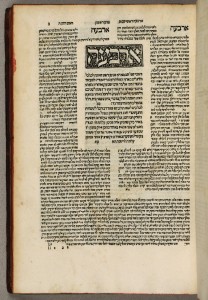 There are many misconceptions about what the Jewish Bible is, arising largely from the fact that only the most dedicated Jewish scholars have engaged in the many years of study required to review and learn what Torah contains, and what it actually is. Some people refer to the Torah as a set of laws, but this is not accurate. Torah, or teachings, refers to more than the Torah scrolls kept in Jewish synagogues and the complete body of “written scripture” which Jews call the Tanach and Christians call the Old Testament. It also refers to the Oral, or spoken, teachings. Books on specific topics have been written by prior and modern sages that collate, codify or explain, information that is found woven throughout different parts of the Torah, for example: Maimonides book listing the 613 positive and negative commandments Jews must adhere to and the laws of careful speech, which is another area of Torah study which merits its own, special, space.
There are many misconceptions about what the Jewish Bible is, arising largely from the fact that only the most dedicated Jewish scholars have engaged in the many years of study required to review and learn what Torah contains, and what it actually is. Some people refer to the Torah as a set of laws, but this is not accurate. Torah, or teachings, refers to more than the Torah scrolls kept in Jewish synagogues and the complete body of “written scripture” which Jews call the Tanach and Christians call the Old Testament. It also refers to the Oral, or spoken, teachings. Books on specific topics have been written by prior and modern sages that collate, codify or explain, information that is found woven throughout different parts of the Torah, for example: Maimonides book listing the 613 positive and negative commandments Jews must adhere to and the laws of careful speech, which is another area of Torah study which merits its own, special, space.
The Written Torah v. the Oral/spoken Torah
The written Torah or “Torah she biktav“, contains the Chumash, psalms, proverbs, the Book of Job, stories of Ruth and Esther, and the writings of the Prophets, among others. The Oral Torah or “Torah shel bal peh” is a somewhat confusing term today, because most of the teachings in this spoken tradition were written down several centuries ago when the sagest rabbis of those times feared that they would become lost to Jewish people eventually if not recorded in writing. Here’s a pretty good explanation of the relationship between different parts of Torah and this is a good general definition of Torah:
…the word Torah includes anything that authentically explains or expands the instructions received at Sinai: the Prophets and Scriptures, the Mishnah, Talmud, Shulchan Aruch (that’s the Code of Jewish Law), and the thousands of books and commentaries on them all. They all fit under the vast, ever-expanding Torah umbrella.
http://www.askmoses.com/en/article/417,66/What-is-Torah.html
Chumash, Pentateuch or 5 Books of Moses
Is the compendium of five books written on Torah scrolls, which is also published as a single volume named Chumash, Pentateuch or 5 Books of Moses – all meaning the same thing in different languages. They are part of the written Torah. The five books are (Hebrew followed by English): Bereshit (In the beginning or Genesis), Shemot (Names or Exodus), Vayikra (He called or Leviticus), Bamidbar (In the desert or Numbers) and Devarim (Words or Deuteronomy).
TANACH is an Acronym aka TANAKH
TANACH is also part of the written Torah. Hebrew has a different alphabet than English, so Hebrew words aren’t always spelled the same when transliterated to English. TANACH is also commonly spelled TANAKH.
…based on the letters T (for “Torah”), N (for “Neviim,” the Prophets), and K (for “Ketuvim,” the Sacred Writings) … The composition of the “TANAKH” was determined by the “Anshei K’nesset HaGedolah,” the Men of the Great Assembly, under the influence of the “Holy Spirit.” It consists of twenty-four “Books,” where first and second volumes of one work are counted as one, and where all the twelve “Books” of the “Trei Asar,” the Twelve Prophets, are also considered as one.
http://www.ou.org/about/judaism/tanakh.htm
Midrashim
Part of the oral Torah are the Midrashim, which are stories giving examples of how Torah is experienced in our lives.
Mishna/Talmud
 Mishna/Talmud, is the part of the oral Torah that lays out rules about how individuals and communities need to interact in order to be fair and uphold righteousness. Each page of Talmud contains a brief passage of Torah, and is surrounded by very tiny text containing the discussions rabbinic sages of Jewish history held in order to determine what that particular passage meant and how its interpretation should be applied to the people of those times in the context of the society in which they lived. Get a lesson in how the layout of a page in the Talmud works. There is a study program that calls for learning one page of Talmud every day, known as Daf Yomi (Page a Day), in which thousands of Jews around the world participate. It takes 7 years to complete.
Mishna/Talmud, is the part of the oral Torah that lays out rules about how individuals and communities need to interact in order to be fair and uphold righteousness. Each page of Talmud contains a brief passage of Torah, and is surrounded by very tiny text containing the discussions rabbinic sages of Jewish history held in order to determine what that particular passage meant and how its interpretation should be applied to the people of those times in the context of the society in which they lived. Get a lesson in how the layout of a page in the Talmud works. There is a study program that calls for learning one page of Talmud every day, known as Daf Yomi (Page a Day), in which thousands of Jews around the world participate. It takes 7 years to complete.
Kabala
Kabala is yet another part of the oral teachings which has its very own rules and knowledge base. Kabala contains some principles and concepts that can be taught but in its highest form, it is received knowledge. Kabala is derived from the Hebrew “mikabel”, meaning: to receive.
Other good information here
http://answers.yahoo.com/question/index?qid=20080331160620AA8hW7U
